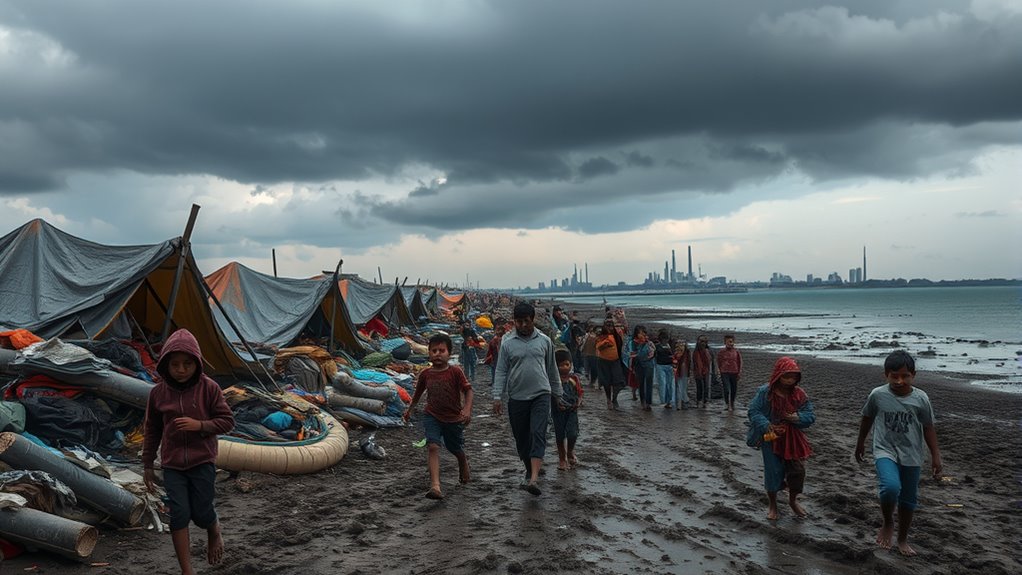Climate migration causes big economic ripple effects that often go unnoticed. When communities relocate due to extreme weather, cities face strain on infrastructure, resources, and services. This can lead to higher costs, social tension, and lower productivity. Resilience strategies and policies help manage these impacts, but implementation faces many hurdles. If you continue exploring, you’ll uncover how cities can turn these challenges into opportunities for growth and stability.
Key Takeaways
- Climate migration strains urban infrastructure, increasing economic costs and reducing productivity in host cities.
- Displacement disrupts local labor markets, leading to skill mismatches and economic instability.
- Insufficient resilience measures escalate damages from extreme weather, heightening recovery expenses.
- Marginalized climate migrants face limited access to resilient housing, deepening economic inequalities.
- Proactive urban policies can transform migration challenges into opportunities for sustainable economic growth.

Have you ever wondered how changing climate patterns are forcing people to move? As extreme weather events become more frequent and sea levels continue to rise, communities worldwide are facing the urgent need to adapt. This shift isn’t just about individual or family relocation; it’s about how cities and governments respond to these pressures through urban resilience and policy adaptation. When cities bolster their resilience, they develop strategies to withstand and recover from climate shocks, reducing the necessity for large-scale migrations. Effective urban resilience involves upgrading infrastructure, improving drainage systems, and creating green spaces that can absorb floodwaters. These measures help communities stay put, minimizing displacement and easing the economic strain on both local and national economies. Additionally, urban resilience strategies can promote community engagement and long-term sustainability, ensuring that adaptations are inclusive and effective.
Policy adaptation plays a vital role in managing climate migration’s ripple effects. Governments that proactively revise land use policies, invest in resilient infrastructure, and create support systems for displaced populations are better positioned to handle the influx of climate migrants. Without these policies, cities risk becoming overwhelmed, leading to increased economic burdens, social tensions, and strained public services. When policymakers recognize the importance of integrating climate risks into urban planning, they set the stage for more sustainable growth. This involves not only planning for immediate impacts but also implementing long-term strategies that anticipate future climate scenarios. For example, zoning laws can be adjusted to restrict construction in flood-prone areas, and incentives can be provided to develop resilient housing. Such policy shifts are essential for safeguarding economic stability and protecting vulnerable populations.
However, many regions lag behind in implementing these adaptive strategies, often due to political inertia, lack of resources, or competing priorities. When policy adaptation is delayed, cities become more vulnerable, and the economic costs of climate migration escalate. Displaced populations may seek refuge in nearby urban areas, adding pressure to already strained resources and infrastructure. This can lead to increased inequality, as marginalized groups often bear the brunt of climate impacts and lack access to resilient housing or social support systems. Conversely, cities that prioritize urban resilience and proactive policy adaptation can better absorb climate migrants, turning potential crises into opportunities for inclusive growth and innovation. By investing in resilience measures today, you can help mitigate future economic shocks and build communities capable of thriving amid a changing climate.
Frequently Asked Questions
How Does Climate Migration Impact Global Supply Chains?
Climate migration impacts global supply chains by causing agricultural disruptions and labor market shifts. You might notice supply shortages or delays as key agricultural regions experience climate-related issues, reducing crop yields. Labor shortages in affected areas can slow down production and logistics, disrupting the flow of goods worldwide. These changes force you to adapt supply chain strategies, increasing costs and uncertainty, highlighting how climate migration reshapes the interconnected economic landscape.
What Role Do Insurance Companies Play in Climate Migration?
Insurance companies play a pivotal role in climate migration by adjusting insurance coverage and refining risk assessment models. You rely on their policies to protect assets in vulnerable areas, but as climate risks increase, insurers may tighten coverage or raise premiums. This influences migration patterns, as people seek affordable options. Their risk assessment helps predict future climate impacts, guiding both policy decisions and community resilience planning.
How Can Developing Countries Prepare for Climate-Induced Displacement?
Did you know that by 2050, up to 200 million people could be displaced by climate change? To prepare, developing countries should focus on agricultural adaptation, helping communities sustain crops despite changing weather patterns. Building social resilience is equally essential, so you can foster stronger, more adaptable communities that can better withstand displacement and its economic impacts, ensuring a safer future for everyone.
What Are the Long-Term Economic Benefits of Climate Migration?
You might wonder about the long-term economic benefits of climate migration. As people move, you’ll see improved economic resilience in host communities, diversifying local economies and boosting productivity. It can also strengthen the labor market by filling skill gaps and supporting innovation. While challenges exist, embracing climate migration can foster sustainable growth, creating opportunities for both migrants and existing residents, ultimately benefiting the broader economy over time.
How Does Climate Migration Influence Urban Infrastructure Planning?
Imagine cities on the brink of transformation—you’re at the heart of urban planning. Climate migration forces you to rethink infrastructure resilience, adapting to sudden population shifts. You must redesign transportation, housing, and utilities to withstand new stresses. The stakes are high, and your decisions today shape the safety and sustainability of tomorrow’s urban landscapes. Will you rise to the challenge, creating resilient cities that embrace change rather than crumble under it?
Conclusion
As you watch these unseen waves of climate migration ripple through economies, remember you’re holding a captain’s wheel. Every displaced person is a pebble tossed into a pond, sending out concentric circles of change. Ignoring this silent tide risks sinking entire communities and economies beneath the surface. Stay alert and engaged, for the storm brewing isn’t just about weather—it’s about your future, too. Together, we can steer toward calmer waters before the waves become unstoppable.










